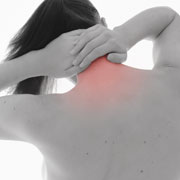LEARN ABOUT YOUR PAIN, UNDERSTAND HOW YOU INJURED YOUR BODY, AND DISCOVER HOW OUR OFFICE CAN HELP.
Understanding the source of neck pain is essential for effective treatment. While MRI findings may suggest a cause, it’s important to also approach the pain from a biomechanical perspective. The position of the head in relation to the chest, shoulders, and trunk can provide valuable insights into the muscular and myofascial involvement in neck pain. Even with MRI findings, addressing the dynamic shearing forces that contribute to the deterioration of spinal structures can help alleviate stress on the muscle and fascia system.

Neck pain is often attributed to upper crossed syndrome, as described in Vladimir Janda’s research, along with the dynamics of the fascia system. Our treatment approach includes myofascial release, posture retraining, and targeted scapular strengthening exercises.
Over the years, there has been extensive research, treatment theories, and applications aimed at reducing neck pain. Dr. Janda identified a muscle imbalance known as upper crossed syndrome, where the sternocleidomastoid and pectoralis muscles become tight and active, alongside the upper trapezius and levator scapulae. These overly tight muscles overpower the inhibited deep cervical flexors, lower trapezius, and serratus anterior. In the mid-19th century, Dr. Berger observed a condition called sternal syndrome, where the rib cage is drawn forward due to the shortening of the abdominal structures and tightening of the pectoralis major. This postural distortion often results in a forward flexed position, placing unusual strain on the body.
The demands on the musculature and spinal structure resulting from this postural distortion can lead to disc deterioration and muscle spasms. Dr. Ida Rolf discovered the pervasive fascial binding throughout the body, particularly affecting areas such as the head, clavicle, T1, jaw, and the base of the skull. Thomas Myers, in his book Anatomy Trains, explores the anatomical dynamics of the fascial system and how it influences the cervical spine and posture from a longitudinal anatomical perspective.
As you can see, there are many dynamics at play. However, my understanding is that by working with you, we can help you understand the root causes of your pain and headaches, what can be done to address them, and how we can alleviate some of your pain and restore your function.
Neck pain develops due to the dynamic forces mentioned earlier, which lead to the deterioration of spinal structures. It’s important to assess specific types of radiculitis and be aware of neurological findings that could result in loss of motor function, reflexes, and movement. In such cases, an MRI can be very useful at the right time. However, when pain issues do not directly correlate with MRI findings, we can proceed with a treatment plan based on our understanding of the biomechanical and postural dynamics. There is a clear correlation between the structure and position of the shoulder girdle, the posture of the trunk, and their contribution to neck symptoms.
Treatment plans are based on postural restructuring, myofascial release and specific strengthening to restore the posture of the truck and the shoulder girdle while strengthening specific weak areas of the neck and shoulder.
LEARN HOW OUR OFFICE CAN HELP YOUR INJURY:
In our office we can help you by evaluating all of these postural defects and help determine when to ask for the proper medical studies. We also have a dynamic program, as well as a multi-cervical strengthening computerized device for inhibited neck muscles. In addition, we have a dynamic program for stabilizing the scapula and sorting out the fascial bindings while restoring proper alignment for the truck, shoulder girdle and neck. Our treatment approach is a full hands-on program that alleviates muscular and fascial dysfunction, a exercise program for specific weak and inhibited muscles, and an overall postural restoration and movement retraining.
LEARN HOW YOU CAN PREVENT FUTURE INJURIES:
By understanding how you got hurt in the first place and treating the specific weakened structures, you now know how to avoid future injuries.
Injuries to the neck, such as whiplash or other severe trauma, typically follow a similar treatment plan. Understanding the mechanism of injury, whether from whiplash or trauma, is crucial, as is allowing sufficient time for healing. A dynamic, ongoing program of hands-on care, combined with an appropriate level of movement, helps facilitate healing and reduces the risk of long-term disability.
Patients with significant and obvious radiculitis should be closely monitored. In such cases, collaboration with a spine surgeon is essential for a thorough diagnosis, and the development of an appropriate treatment plan, which may or may not involve surgical intervention.
Patients with radiculitis unrelated to cervical spine dysfunction can benefit from the aforementioned program, which helps alleviate nerve tissue entrapment at the fascial level, often worsened by poor posture and weakened muscles.
